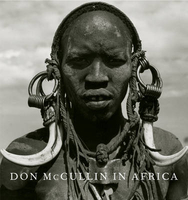-
Home
-
Contributors
-
International
-
Account
-
Information
More From Contributor
- a subject of timely pertinence. ...
- ...
- Miguel De Cervantes ...

Don McCuillin In Africa
Sudan. There he has entered the tribal lands of the Surma, the Gheleb, the Bume, the Erbore, the Bene, the Bodi, the Karo, the Hamar and the Mursi. Extraordinary body paints decorate many of their bodies. Metalwork adorns their limbs, and, in the case of the Mursi, huge circular plates extend their lower lips and piercings open up large holes in their ear lobes.Ritualistic stick battles are enacted with ferocity. Rifles and machine guns are often cradled in the hands of warriors. The violence McCullin witnessed was staged but real dangers were close. African tribespeople can present another face of the exotic to those of us in modern, developed cultures, especially if the photography recognises nothing of their dignity but all of their exoticism. McCullin knows too much to fall
into that trap. McCullin`s subjects retain their dignity and also become heroic. We, the viewers, can be amazed by their strength and beauty, and all the more so because McCullin`s compassionate photography enables us to understand their vulnerability. McCullin`s photographs will be prefaced by extracts from his diaries.
This page now acts as a permanent archive for this product. Add more information using the comments box below to ensure it can still be found by future generations.
Use our search facility to see if it is available from an alternative contributor.
- Availability: Out Of Stock
- Supplier: Stanfords
- SKU: 9780224075145
Product Description
Don Mc Cullin`s reputation stands as one of the greatest war photographers of our times. In recent years he has photographed the landscape surrounding his home in Somerset, but his later travels have taken him to some of the most remote regions in the world. His skill in photographing people in extreme situations has enabled him to mix with tribes on the edges of civilisation. His work among the people of Irian Jaya, including cannibals, appeared in his last book, Don Mc Cullin. Mc Cullin`s new work in Africa reaches one of the last corners of the earth where signs of outside influence are few, though they appear ominously significant. Over the last two years Don Mc Cullin has travelled south from Addis Ababa in Ethiopia to the valley of the Omo River leading down to the border with Sudan. There he has entered the tribal lands of the Surma, the Gheleb, the Bume, the Erbore, the Bene, the Bodi, the Karo, the Hamar & the Mursi. Extraordinary body paints decorate many of their bodies. Metalwork adorns their limbs, &, in the case of the Mursi, huge circular plates extend their lower lips & piercings open up large holes in their ear lobes. Ritualistic stick battles are enacted with ferocity. Rifles & machine guns are often cradled in the hands of warriors. The violence Mc Cullin witnessed was staged but real dangers were close. African tribespeople can present another face of the exotic to those of us in modern, developed cultures, especially if the photography recognises nothing of their dignity but all of their exoticism. Mc Cullin knows too much to fall into that trap. Mc Cullin`s subjects retain their dignity & also become heroic. We, the viewers, can be amazed by their strength & beauty, & all the more so because Mc Cullin`s compassionate photography enables us to understand their vulnerability. Mc Cullin`s photographs will be prefaced by extracts from his diaries.
Reviews/Comments
Add New
Intelligent Comparison
We couldn't find anything!
Perhaps this product's unique.... Or perhaps we are still looking for comparisons!
Click to bump this page and we'll hurry up.
Price History
Vouchers
Do you know a voucher code for this product or supplier? Add it to Insights for others to use.


 United Kingdom
United Kingdom
 France
France
 Germany
Germany
 Netherlands
Netherlands
 Sweden
Sweden
 USA
USA
 Italy
Italy
 Spain
Spain










 Denmark
Denmark